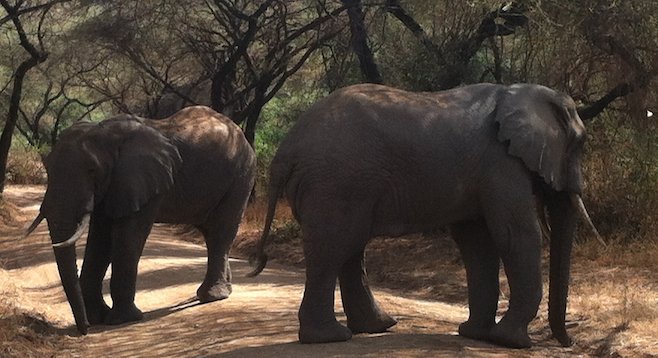 Facebook
Facebook
 X
X
 Instagram
Instagram
 TikTok
TikTok
 Youtube
Youtube

Three turns into the park, our Land Rover was forced to a stop as two large bull elephants sauntered across the road. Their tusks protruding forward, as if they were divining rods steering them into the forest on the opposite side of the dirt track where we sat. Even though there was no rush on the giant pachyderms’ part, the moment in our minds came and went far too quickly.
Welcome to Lake Manyara National Park, a 30-mile stretch of land that sits in Africa’s Great Rift Valley. Unlike the vast plains of the Serengeti, this often-overlooked preserve is heavily wooded with abundant water.
From afar, the lake could be mistaken for an ocean; the shoreline melts unceasing into the horizon. Bands of pink and white dance in the heat waves as the sun reflects off the thousands of huge white storks and flamboyant greater and lesser flamingos. The size of Africa’s birds is confounding – one wonders how it’s possible for such large animals to take flight.
As beautiful as the birds are, it’s the mammals that lure people to safari. Especially the large mammals. Lake Manyara does not disappoint. As we wound our way through the park on the dust-covered roads, we were rewarded with views of giraffes feeding on acacia trees, their necks stretched to the top of the canopy. Groups of zebra, Cape buffalo and wildebeest grazed together in the open grass. Troops of baboons played, and comical-looking warthogs trotted along as if they were auditioning for the Lion King.
The forest provides a certain intimacy with nature, helping you feel somewhat isolated as the trees block the view of the many other Land Rovers touring the preserve. It’s only when you stop for lunch or near the lake that you realize there are many other tourists also enjoying the awe-inspiring sites of Africa.
Lake Manyara is located in northern Tanzania and most visitors to the park arrive from Arusha. Entrance into the park is only allowed with a registered Tanzanian licensed tour operator. Nighttime tours are also available. If you choose one it is unlikely you will see animals feeding, although you’re sure to see the heavily armed anti-poaching guards who patrol the park.
Safari prices vary greatly. However, it's safe to say that purchasing a safari once you arrive in Africa will cost you a minimum of one-third less than if you purchase through a U.S. outfitter prior to leaving the States. Cost aside, seeing the wonders of Africa in person before they vanish may truly be one of the few priceless items remaining on Earth.


Three turns into the park, our Land Rover was forced to a stop as two large bull elephants sauntered across the road. Their tusks protruding forward, as if they were divining rods steering them into the forest on the opposite side of the dirt track where we sat. Even though there was no rush on the giant pachyderms’ part, the moment in our minds came and went far too quickly.
Welcome to Lake Manyara National Park, a 30-mile stretch of land that sits in Africa’s Great Rift Valley. Unlike the vast plains of the Serengeti, this often-overlooked preserve is heavily wooded with abundant water.
From afar, the lake could be mistaken for an ocean; the shoreline melts unceasing into the horizon. Bands of pink and white dance in the heat waves as the sun reflects off the thousands of huge white storks and flamboyant greater and lesser flamingos. The size of Africa’s birds is confounding – one wonders how it’s possible for such large animals to take flight.
As beautiful as the birds are, it’s the mammals that lure people to safari. Especially the large mammals. Lake Manyara does not disappoint. As we wound our way through the park on the dust-covered roads, we were rewarded with views of giraffes feeding on acacia trees, their necks stretched to the top of the canopy. Groups of zebra, Cape buffalo and wildebeest grazed together in the open grass. Troops of baboons played, and comical-looking warthogs trotted along as if they were auditioning for the Lion King.
The forest provides a certain intimacy with nature, helping you feel somewhat isolated as the trees block the view of the many other Land Rovers touring the preserve. It’s only when you stop for lunch or near the lake that you realize there are many other tourists also enjoying the awe-inspiring sites of Africa.
Lake Manyara is located in northern Tanzania and most visitors to the park arrive from Arusha. Entrance into the park is only allowed with a registered Tanzanian licensed tour operator. Nighttime tours are also available. If you choose one it is unlikely you will see animals feeding, although you’re sure to see the heavily armed anti-poaching guards who patrol the park.
Safari prices vary greatly. However, it's safe to say that purchasing a safari once you arrive in Africa will cost you a minimum of one-third less than if you purchase through a U.S. outfitter prior to leaving the States. Cost aside, seeing the wonders of Africa in person before they vanish may truly be one of the few priceless items remaining on Earth.
Comments